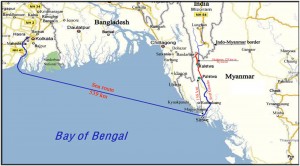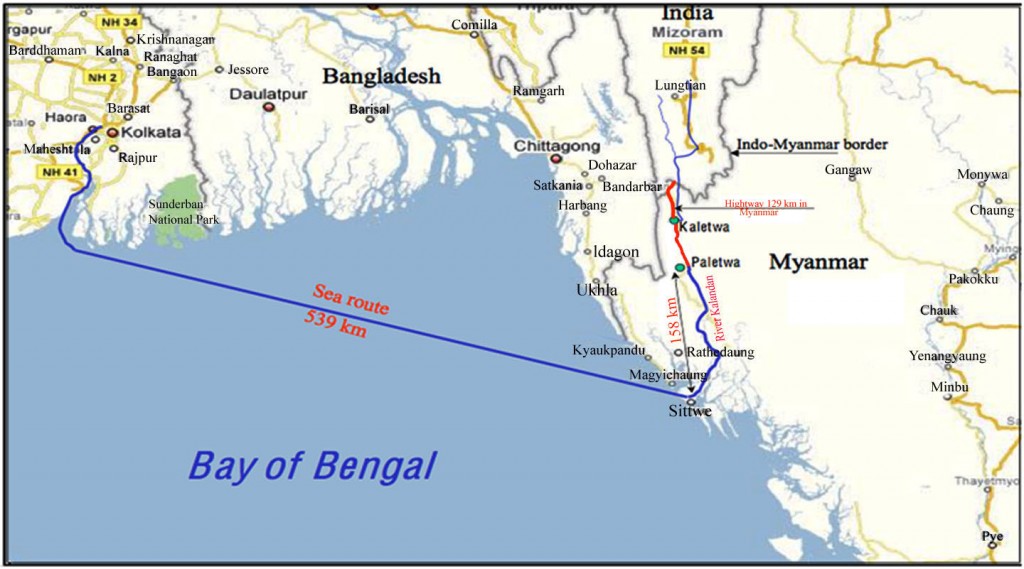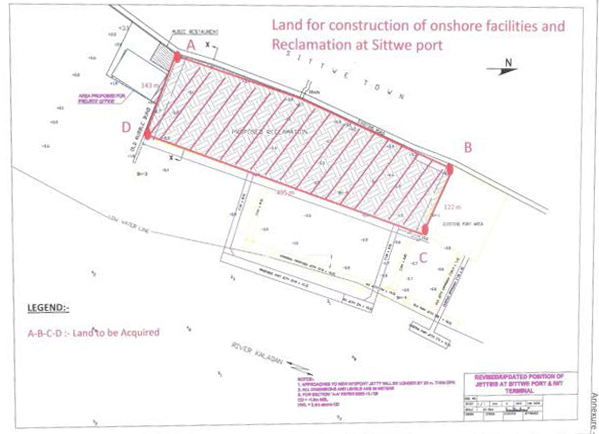 On April 2, 2008, the Indian government signed an agreement with the Myanmar military regime for the Kaladan Multi-Modal Transit Transport Project which is also known as the Kaladan Project. The project will connect Eastern Indian seaports, particularly Kolkata seaport in East India, with the seaport in Western Myanmar's Rakhine State capital, Sittwe—a total distance of 593km. It will then link Sittwe to the landlocked area of Mizoram in Northeastern India via river and road transport. The project is divided into three main phases:
On April 2, 2008, the Indian government signed an agreement with the Myanmar military regime for the Kaladan Multi-Modal Transit Transport Project which is also known as the Kaladan Project. The project will connect Eastern Indian seaports, particularly Kolkata seaport in East India, with the seaport in Western Myanmar's Rakhine State capital, Sittwe—a total distance of 593km. It will then link Sittwe to the landlocked area of Mizoram in Northeastern India via river and road transport. The project is divided into three main phases:
Phase 1: Development of Sittwe port to handle the future increase in shipping levels. This includes the expansion of its seaport and the construction of a new inland waterway terminal (IWT). This entails dredging the approach channel and the port area (some 562,000 cubic meters of material) to facilitate 6,000-ton ships, as well as constructing two jetties and extensive loading and storage facilities that will significantly expand Sittwe’s current size and capacity. The larger 219m x 15m port jetty will be capable of handling 20,000-ton ocean freighters, and a 54m x 15m inland waterway terminal (IWT) jetty will cater to smaller vessels that ply the river. At present, Sittwe’s port consists of a 78m x 15m jetty and is appropriate for vessels of 2,000- 3,000 tons.
Detailed Route of Kaladan Multi-Modal Transit Transport Project from India to Myanmar through Sittwe
Phase 2: Dredging of 225km of the Kaladan River between Sittwe and Setpyitpyin (Kaletwa) in Chin State where another terminal will be built.
Phase 3: Construction of a 62km highway between Setpyitpyin (Kaletwa) and the Mizoram border of Indiaii .
Originally, the first and second phases of the project were to begin before the end of 2009. However, construction only started in November 2010. The development of phases 1 and 2 in Sittwe, the river dredging and the IWT at Kaletwa were primarily executed by the state-run Inland Waterways Authority of India with Essar Projects Ltd, Mumbai (a division of the Essar Group appointed in May 2010 as the main contractor). Both RITES and IWAI are state-run Indian companies. But the third phase of highway construction will be headed by the Burmese Ministry of Transport. The construction of the highway from Paletwa to the India-Burma border was originally scheduled to start from the year 2011-12; however, the construction has now been delayed. The entire project is planned to be completed in three years (2014-5), with work suspended for five to six months of the year due to the monsoon.
Detailed Engineering Plan of Sittwe Port
Development Stages of the Project
Due to the challenging and technical difficulty of dredging small islands and rocks, especially the upper part of the Kaladan River, the second and third phases have had to be altered: dredging of 225km of the Kaladan River between Sittwe and Setpyitpyin (Kaletwa) has been reduced to 158 km between Sittwe and Paletwa in Chin State, where another IWT terminal is being built at Paletwa to transfer cargo from river to road transport. As a result, the construction of the highway has to be extended from 62km to 129km between Paletwa in Burma’s Chin State and the Mizoram border of India.
According to Mr. N Unni, Project Coordinator from IWAI, shifting the location of the planned Kaletwa river port further downriver to Paletwa has reduced the amount of dredging required by around 95 percent. Thus, it will now only take place at four or five sites to ensure a minimum depth of two meters, and no rock blasting or land acquisitions are needediii . Therefore, more than 400 tons of estimated explosives required for the river dredging will be totally avoidediv .
The project has been piloted and funded by the Indian Ministry of External Affairs. The preliminary feasibility studies, such as hydrographic surveys, etc., were carried out by the state-run Rail India Technical and Economic Services (RITES). However, no open and clear transparency regarding these studies has been made public. The development of Sittwe port and Kaladan waterway is expected to cost US $68.24 million, and the highway construction between Kaletwa and the Indian border is expected to be around US $49.14 million.
According to the April 2008 Framework Agreementv , the Government of the Union of Myanmar will provide the required land and security for the project, including for all personnel and technicians, free of charge. The Indian government will bear the full cost of the project, which was originally estimated at US $120 million, although more recently the cost has been estimated as US $134 million. Under previous agreements, the Burmese junta was supposed to contribute US $10 million to the project; however, in 2007 the Indian Government extended Burma a minimum interest loan in order to cover this. In the April 2008 agreement, it does not explicitly mention that the Burmese government is under any financial obligation for the cost of the Kaladan Project.
After completion, the project will be handed over to the Burmese government on the terms and conditions mutually agreed upon in the April 2008 Framework Agreement. These terms and conditions are outlined in two supplementary documents, however, they have not yet been made public. It is anticipated that the Burmese state will take full ownership of the transport system, but it will primarily be used by Indian companies to increase trade with Southeast Asia and links to the land-locked Mizoram region. It is expected, however, that few local citizens will use the Kaladan, since they will not be able to afford the tolls that the Burmese government will impose on vessels using the waterway.
Original Link Mizzima
